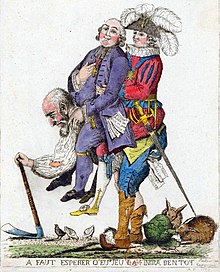
Back Ständeordnung ALS طبقات المجتمع الأوروبي في العصر القديم Arabic Estamentu AST Ҡатлам Bashkir Саслоўе Byelorussian Стан (сацыяльная група) BE-X-OLD Съсловие Bulgarian Teir urzh ar gevredigezh Breton Estaments Catalan Stavy Czech
This article needs additional citations for verification. (September 2021) |



The estates of the realm, or three estates, were the broad orders of social hierarchy used in Christendom (Christian Europe) from the Middle Ages to early modern Europe. Different systems for dividing society members into estates developed and evolved over time.[1][2]
- The best known system is the French Ancien Régime (Old Regime), a three-estate system which was made up of a First Estate of clergy, a Second Estate of titled nobles, and a Third Estate of all other subjects (both peasants and bourgeoisie).
- In some regions, notably Sweden and Russia, burghers (the urban merchant class) and rural commoners were split into separate estates, creating a four-estate system with rural commoners ranking the lowest as the Fourth Estate.
- In Norway, the taxpaying classes were considered as one, and with a very small aristocracy; this class/estate was as powerful as the monarchy itself. In Denmark, however, only owners of large tracts of land had any influence. Furthermore, the non-landowning poor could be left outside the estates, leaving them without political rights.
- In England, a two-estate system evolved that combined nobility and clergy into one lordly estate with "commons" as the second estate. This system produced the two houses of parliament, the House of Commons and the House of Lords.
- In southern Germany, a three-estate system of nobility (princes and high clergy), knights, and burghers was used; this system excluded lower clergy and peasants altogether.
- In Scotland, the Three Estates were the Clergy (First Estate), Nobility (Second Estate), and Shire Commissioners, or "burghers" (Third Estate), representing the bourgeoisie and lower commoners. The Estates made up a Scottish Parliament.
Today, the terms three estates and estates of the realm may sometimes be re-interpreted to refer to the modern separation of powers in government into the legislature, administration, and the judiciary.[citation needed] The modern term the fourth estate invokes medieval three-estate systems, and usually refers to some particular force outside that medieval power structure, most commonly the independent press or the mass media.[3][4]
- ^ "The Ancien Regime | History of Western Civilization II". courses.lumenlearning.com. Retrieved 2023-07-14.
- ^ "Taxes and the Three Estates | History of Western Civilization II". courses.lumenlearning.com. Retrieved 2023-07-14.
- ^ Kathy Gill (16 January 2020). "What Is the Fourth Estate?". ThoughtCo. Retrieved 16 April 2024.
- ^ "fourth estate". Dictionary of Media and Communication. Oxford Reference. Retrieved 16 April 2024.